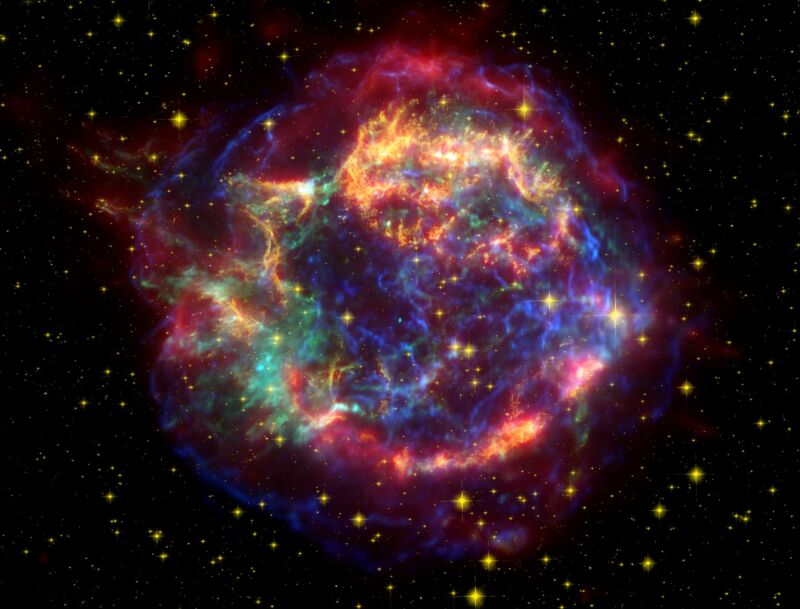On the rebound —
We’re still trying to understand the mechanics that allow a star to self-destruct.
John Timmer
–

Enlarge / A multi-wavelength image of the Cassiopeia A supernova remnant.
Supernovae happen. We’ve witnessed enough of them that we’re pretty sure of that. Why they happen has been another issue entirely. As we’ve worked to understand the physics that drives these immense explosions, we’ve occasionally gone through awkward periods when the stars in our models stop exploding. Adding in more realistic physics has generally gotten the models booming again, and right now we’re in a period where the latest models appear to be happily self-destructing.
The challenge is trying to find evidence that the physics we’re using in our successful models accurately reflects what’s going on in a dying star—not an easy task with an event that instantly destroys much of the evidence.
Now, data from the Chandra X-ray Observatory provides a hint that a mechanism used in recent supernova models is probably right. The results are published in this week’s issue of Nature.
It goes boom (mostly)
The supernovae at issue here occur when a massive star runs out of fuel, leading its core to collapse. Right here, you can see a potential issue: how does a collapse lead to an explosion?
The general idea is that, once fuel runs out and fusion stops, the inner core of the star collapses into a neutron star. Layers above the core, deprived of the energy that pushed them outward, plummet toward the core, hit the neutron star, and rebound. This rebound is then what blows the outermost visible layers of the star to pieces.
Unfortunately, this doesn’t exactly work. The outer layers of the star also get cut off from the energy that counteracted the pull of gravity, and they start plunging toward the core, too. Somewhere inside the star, the rebounding layers blasting outward will run into the more distant layers still collapsing inward. The result is a shock front that stalls before it reaches the surface of the star. Nothing goes boom.
The balancing point is reached close enough to the star’s surface, however, that an additional input of energy would be sufficient to flip things back over into an exploding mode. And physicists came up with a rather unlikely source for this energy: neutrinos. These particles are notable for rarely interacting with other matter, so they would seem to be a terrible candidate to transfer energy to the material churning in the outer layers of the star. But so many of them are produced during the core collapse that neutrino-driven heating is a thing, even if it’s not a thing that you’d want to have reheating your leftovers.
And, fortunately in this context, it’s a thing that has consequences. The material that gets heated by neutrinos continues trying to expand to escape the star. The material that hasn’t been baked by neutrinos is still doing its best to collapse. The result is some dramatic convection in the outer layers of the star, as collapsing and exploding materials churn past each other. This has the potential to create asymmetric explosions, which is something we’ve seen happening. And it also has consequences for the material that gets ejected.
The freeze-out
Neutrino-driven heating may seem a bit weird, but one of its consequences is equally strange. The heated material forms what physicists call a “high-entropy plume.” In this case, the high entropy simply refers to a combination of low density and extremely high energies. It’s high enough that some of the recently formed atoms end up being disassembled down to protons, neutrons, and alpha particles, a two-neutron/two-proton combination. (An alpha particle is the same as the nucleus of a typical helium atom.)
As the material cools, however, the energy and density drop to where all this material starts forming larger atomic nuclei in a process that’s called an alpha-rich freeze-out. This process has a distinct atomic signature, as the physics of the freeze-out are likely to form a number of specific elements and isotopes. So, by looking at the remains of the exploded star, we can potentially find evidence that an alpha-rich freeze-out took place.

Enlarge / Detailed image, showing the high-velocity, iron-rich plumes in the lower left.
And that’s exactly what has been done in this new study. One of the isotopes produced in alpha-rich freeze-outs is 56Ni, which rapidly decays to 56Fe. And previous imaging of the supernova remains at Cassiopeia A has shown that there are areas within the ejected material that are iron-rich. So, a collaboration between US and Japanese researchers searched these iron-rich regions for the presence of chromium and titanium, which are also produced during an alpha-rich freeze-out.
Obviously, the researchers found them, or this article wouldn’t have needed to be written. Just as critically, chromium and titanium were present in amounts that were consistent with their formation in a proton-rich, high-energy plume of material.
Just as significantly, the models of supernova suggest that the plumes of material driven by neutrino heating should be traveling in the neighborhood of 4,000 to 5,000 kilometers a second. And the iron-rich material is moving at over 4,000 kilometers a second, putting it in the right neighborhood.
All of which suggests that our current models of exploding stars appear to be on the right track. Not only do the model stars actually explode—they do so in a way that appears to be consistent with an existing supernova remnant. Obviously, this will be something we’ll want to look at other supernova remains to confirm. But for now, at least, the model builders can enjoy the relief of having good reason to believe they’re not badly off track.
Nature, 2021. DOI: 10.1038/s41586-021-03391-9 (About DOIs).

